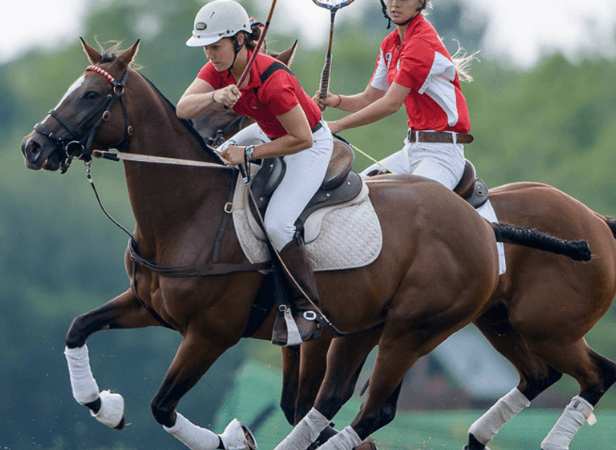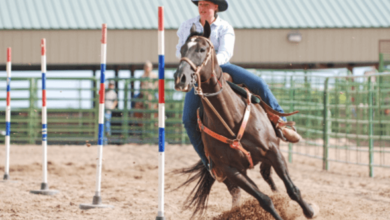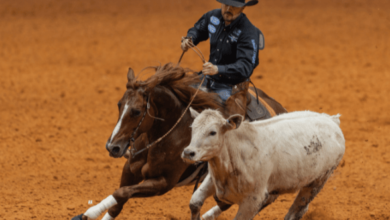Training a horse for polocrosse requires a blend of equestrian skills, athletic conditioning, and specific drills to prepare both the rider and the horse for the demands of the sport. Polocrosse is a fast-paced game that combines elements of polo, lacrosse, and horsemanship. It requires agility, speed, and coordination, making the training of a horse for this sport crucial. In this comprehensive guide, we will explore the essential steps and techniques for training a horse for polocrosse, from groundwork to advanced skills, ensuring that both horse and rider can excel on the field.
Understanding Polocrosse
Before delving into the training process, it’s important to understand the nature of polocrosse and what makes it unique. Polocrosse is played with a racquet, a ball, and a team of horses and riders. The objective is to score goals by throwing the ball into the opponent’s net while controlling the horse with precision. The game involves a high level of physical contact and rapid movements, requiring horses to be nimble and responsive.
Selecting the Right Horse for Polocrosse
Choosing the right horse is the first step in successful polocrosse training. While any horse breed can theoretically be trained, certain qualities make a horse more suitable for the game:
- Temperament: A calm yet responsive horse is ideal. The horse should be able to remain composed in high-pressure situations and not be easily startled by sudden movements or noises.
- Athleticism: The horse should possess good stamina, speed, and agility. This includes the ability to change direction quickly and accelerate on demand.
- Size: A medium-sized horse is often preferable as it offers a balance between agility and strength, making it easier to maneuver on the field.
Groundwork: Establishing Trust and Obedience
Before introducing the horse to the specific movements and demands of polocrosse, establishing a solid foundation through groundwork is critical. This helps build trust between the horse and rider, ensuring better communication and control.
- Basic Commands: Train the horse to respond to basic commands such as stop, go, and turn. These commands will be the building blocks for more complex maneuvers.
- Desensitization: Given the fast nature of polocrosse, a horse should be comfortable with various noises and sudden movements. Expose the horse to different stimuli like balls, racquets, and crowds.
- Lunging: Lunging helps in building the horse’s balance and obedience. It allows the horse to develop the ability to change gaits and directions smoothly.
Conditioning the Horse for Endurance and Agility
Polocrosse is physically demanding, and a horse must be in peak physical condition to perform well. This involves a carefully structured fitness regime focusing on endurance, agility, and strength.
- Cardiovascular Training: Start with long, steady rides at a trot and canter to build cardiovascular endurance. Gradually increase the intensity and duration to ensure the horse can maintain stamina throughout a game.
- Hill Work: Incorporating hill work into the training routine helps in strengthening the horse’s hindquarters, crucial for quick sprints and turns.
- Interval Training: Practice short bursts of speed followed by slower paces to mimic the stop-start nature of polocrosse. This helps the horse become more adaptable to the varied pace of a game.
Introducing the Horse to the Racquet and Ball
The horse must become comfortable with the unique equipment used in polocrosse. This step is key to ensuring the horse remains calm and responsive during a game.
- Familiarization with the Racquet: Begin by allowing the horse to see and smell the racquet while on the ground. Once the horse is comfortable, practice holding the racquet while mounted.
- Dribbling Practice: Practice dribbling the ball while riding at a walk, then gradually increase the speed. This helps the horse get used to the movements and sounds associated with the ball.
- Ball Pick-Up Drills: Train the horse to remain still while you pick up the ball from the ground using the racquet. This requires patience and consistency but is essential for game situations.
Developing Maneuverability: Turning, Stopping, and Changing Direction
One of the core skills a horse needs in polocrosse is the ability to turn sharply and change direction on command. Training for these movements is crucial for effective gameplay.
- Figure-Eight Patterns: Practice riding in figure-eight patterns to improve the horse’s flexibility and ability to change direction smoothly. Start at a walk, then progress to a trot and canter.
- Sliding Stops: Teach the horse to perform sliding stops. This maneuver is important for quickly halting during defensive play.
- Side Passing: Practice side passing, where the horse moves laterally while staying parallel to the ground. This skill is useful when positioning for a ball or making quick adjustments on the field.
Teamwork: Building Rider-Horse Synchronization
Polocrosse is as much about the rider’s skill as it is about the horse’s training. Developing a seamless connection between the horse and rider enhances performance.
- Leg and Rein Cues: Ensure that the horse is responsive to subtle leg and rein cues. This makes it easier to direct the horse without having to rely solely on pulling the reins.
- Speed Transitions: Practice transitioning between different gaits—walk, trot, canter, and gallop. The horse should be able to change speed quickly and smoothly upon the rider’s cue.
- Mounted Games Practice: Participate in simulated polocrosse games or mounted games sessions. This allows the horse to practice with teammates and get accustomed to the dynamic nature of actual gameplay.
Simulating Game Conditions
As the horse becomes more comfortable with the basics, it’s time to introduce it to game-like scenarios. This prepares the horse for the intensity of actual polocrosse matches.
- Practice with Other Horses: Playing with other horses helps in accustoming your horse to the close-contact nature of polocrosse. It learns how to stay composed amidst other horses and riders.
- Small-Sided Matches: Engage in smaller scrimmages or practice matches. This helps to build the horse’s confidence and prepares it for the rapid pace and strategic movements required in real games.
- Sideline Exposure: Introduce the horse to the sideline environment, including spectators, to ensure it remains calm during games.
Addressing Common Challenges in Training
Training a horse for polocrosse comes with its own set of challenges. Understanding these issues and addressing them promptly can make a significant difference in the horse’s development.
- Spooking: Horses new to polocrosse may spook at the sight of a flying ball or swinging racquet. Address this through consistent desensitization exercises.
- Resistance to Turning: Some horses may resist making quick turns. Address this by practicing turning exercises daily, ensuring the horse is comfortable with the movements.
- Overexertion: Given the physical demands, it’s crucial not to overtrain the horse. Monitor signs of fatigue, provide adequate rest, and ensure a balanced diet.
Maintaining the Horse’s Well-being During Training
The well-being of the horse should always be a priority throughout training. A healthy horse is more likely to perform better and recover faster after games.
- Diet and Nutrition: Ensure the horse receives a balanced diet that meets its energy needs. Consult with an equine nutritionist for tailored advice.
- Regular Veterinary Check-ups: Regular health check-ups, including dental care and vaccinations, keep the horse in optimal condition.
- Cooling Down: After each training session, spend time cooling down the horse to prevent muscle stiffness and aid in recovery.
Conclusion: Building a Successful Polocrosse Team
Training a horse for polocrosse is a rewarding journey that demands patience, dedication, and understanding of the sport’s unique requirements. From selecting the right horse to mastering complex maneuvers, each step builds towards creating a strong partnership between horse and rider. With consistent training and care, your horse can become an agile, confident, and skilled polocrosse player, ready to take on the challenges of the game





